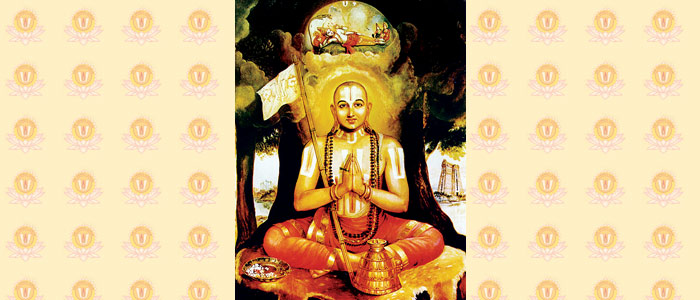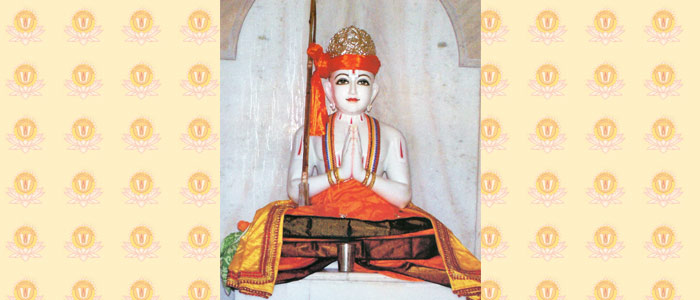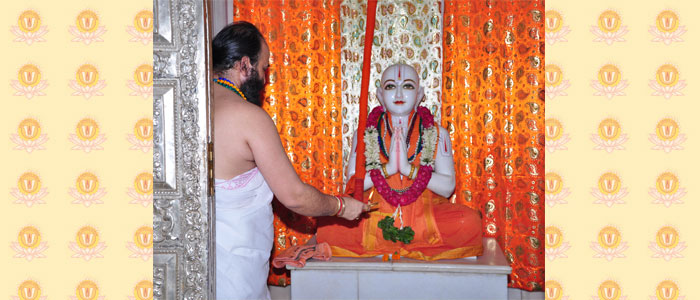Shri Ramanujacharya
The founder and the leading expounder of Vishisht-advait (philosophy of qualified non-duality) doctrine Bhagwan Bhashyakar Swami Ramanujacharyaji incarnated on the pious land of Tamil Nadu nearly a thousand years back in the year 1017. His mother's name was Kantimati and father became renowned over the world as Shri Keshavacharya. Shri Mahapoorna Swamiji was the guru who initiated Ramanujacharya; at the same time he considered Nathmuni as well as Yamunacharya too as his Gurus. He was well-adorned with an amazing set of virtues and talent right from his childhood. He got married in his early youth. After his father's demise, he started living in Kanchipuram along with his family.
Ramanujacharya is considered to be the reincarnation of Bhagwan Shesha, the snake God who bears the earth on his hood. As is illustrated here :
Prathamo-ananta-rōpashcha dwitiyo Lakshmanastathā
Tritiyo Balrāmashcha kalau Rāmānujo munih.
Lord LakshmiNarayana's eternal bedstead, ordained with distinct benevolent characteristics, Lord Shesha is considered to be the foremost incarnate. Second time he took birth in Tretā yug as Lakshman, the younger brother of Lord Shri Rama and got the opportunity to be in Lord Ram"s constant service. Later, in Dwāpar yug he took birth as Balram, the elder brother of Lord Shri Krishna, who was an embodiment of strength and remained in constant service of Lord Shri Krishna. And in Kaliyug he reincarnated as Shri Ramanujacharya. And the fifth incarnation is considered to be that of the great grammarian Patanjali.
From all these avatars the incarnation of Ramanujacharya is considered to be having its distinct philanthropic characteristic which takes the being towards deliverance; it is considered to be the basis of the path of salvation for which a being is initiated as a sojourner on the path of complete surrender. That is why it is said :
"Ramanuj sambandhān-mukti-mārgah"
Ramanuja is the preceptor of the Veda sanctioned doctrine. He is associated with the Supreme Being Shri LakshmiNarayana. His preeminent goal is to release human beings from their materialistic involvements, showing them the path to deliverance thus leading them in direct unison with the Lord Almighty. Hence :
Lakshmināth samārambhām Nāth-Yāmun-madhyamām
Asmad-āchārya paryantām vandé guru paramparām.
Due to his profound talent Ramanuja could comprehend eloquent philosophical essence even at a young age and possessed the capability of presenting his original elucidation and exposition. And as such, he even expressed his disagreement with his master Yadav Prakashji on the exposition of the Vedas.
The form of disagreement is as follows - the word 'kapyāsah' was interpreted by Shri Yadav Prakash as - 'Lord's eyes are as red in colour as the lower part of a monkey's body'! But Ramanuja, with his profound skill and literary wisdom, while interpreting the description, "Jalam pivati iti kapih sūryah, tén aasyaté kshipyaté iti kapyāsam kamalam" went on to explain that 'kapyāsah' word here means that 'Lord Narayana's pair of eyes is like a freshly blossomed bunch of bright lotus' flowering in the deep water and supported by the gleaming rays of the rising sun.' He presented such a beautiful explanation which is in accordance with the shāstras as well as the society. This caused spite in his Guru's heart. He conspired to kill Ramanujacharya. But Lord Varadaraja saved him in the guise of a hunter couple.
Yadava Prakashji developed this animosity towards Ramanujacharya due to the unpleasant influence of the brahma demon on a princess. The princess was terrorised by the brahma-demon and all the realised men and highly accomplished saints proved to be unsuccessful in liberating her from that terror. So, Yadav Prakshji was called for this. He reached there with his disciple Ramanuja but all his supernatural spells and incantations proved to be of no avail; instead the demon terrorising the princess said that none of his spells and charms are going to have any effect on him. He further said that if his disciple Ramanuja agrees to grant him his foot-nectar, he would leave. And that is what exactly happened. Brahma-demon left after having Ramanuja's foot-nectar. This caused even more heartburn in Yadava Prakash's heart.
Yadava Prakash was impressed by the analytical powers of Ramanujacharya but did not agree with his views on religious devotion. After a protracted disagreement on the interpretation of religious devotion, he forbade Ramanuja from coming to his house. Thereafter, Ramanujacharya's childhood guardian Kānchipūrnaji suggested him to go and meet his guru Yamunacharya. On his recommendation, Ramanuja embarked on his journey to Srirangam along with his family, to meet Yamunacharyaji. Unfortunately, even before he could reach there, Yamunacharya left for his heavenly abode. On reaching there Ramanujacharya observed that three fingers of Yamunacharya were twisted. This made him realised that Yamunacharya was worried on three accounts. Ramanujacharya vowed to complete all the three tasks. This led to the straightening of the three fingers of Yamunacharya.
Accepting Yamunacharya as his conceptual guru, he learnt about his philosophical notions for six months from his disciple Shri Mahāpūrna. He did not join the community for over a year. Hereafter Ramanujacharyaji started a foot-march. During this march, he undertook philosophical deliberations with the care-takers of Vishnu temples. After losing to him in the debates, they all became his followers. He got quite a few temples re-constructed. This led to the propagation of the Vaishnava doctrine. During this period, he authored seven scriptures.
- Shri-Bhāshyam – This scripture is a universally authenticated commentary on the Brahma Sutras espoused by Bhagwan Vardāyana Vyāsa.
- Gita Bhāshyam – In this, Shrimad Bhagwadgita has been analysed and explained and it comprises of a hearty depiction of Lord Krishna.
- Vedarth Sangrah (a resume of vedanta) – In this scripture, Veda approved doctrines of monism and dualism have been refuted and true meaning of Upanishad has been established.
- Vedānt Deepa (the light of vedanta) - This is an abridged version of Shri Bhāshya. It is extremely simple.
- Vedānt-sār (essence of vedanta) – The smallest form of Shri Bhāshya. It is the primary scripture for Vishisht advait.
- Gadhya-thrayam (three prose hymns) – This incorporates Sharnāgati Gadya, Vaikunth Gadya and Shrirang Gadya.
- Ārādhana Granth – The subject matter of Lord's worship has been expounded in this scripture.
His most famous treatise is Shri Bhāshya. Goddess Saraswati, the deity of knowledge had honoured him with the title of Bhashyakār (A commentator of repute) after hearing his interpretation of 'Kāpyasām Pundarēkāksham' at the Sri Bhandaram library in Kashmir. Since then he has come to be known as Bhashyakār Ramanujacharya.
Instituting Vishisht-advait, according special status to Lord Lakshmi Narayana and establishing the popular doctrine of Vaishnava all these have been distinguishing characteristics of Ramanujacharya. The theory of monism offers natural environment for a debate on this issue. The source of Ramanuja's belief is the popular Tamil poem 'Shāstriya Vichāron Kā Pratipādan'. It is a confluence of both the Vedāntas.
After his emotional surrender on the feet of Shri Yamunacharya his statue in wax in the posture of Padmāsana (a posture of yoga) and deeply absorbed in meditation was installed at the Ranganath temple in Srirangam. It is believed that seeking his blessings here before offering services at various famous Vaishanava temples is auspicious.
After serving and propagating the philosophy of Vaishnava dharma's Vishisht-advait and attaining the age of almost a hundred and twenty years, he left for his heavenly abode gathering all his magnificence. He even made an appeal to his own disciples to forgive him for his sins, whatsoever. He finally left for his heavenly abode on the tenth day of the Shukla paksha of the month of Magh, which happened to be a Tuesday in the year 1137.
Swami Ramanujacharyaji was indeed a great theologian whose life and teachings have had a lasting influence on the development of theistic thought in India.
His introduction of the Godhead as the absolute entity with supersubjective characteristics and his having pioneered the dawning of devotion to Godhead opened the doors for future theistic reformers who would in due course fully reveal the highest potential of the soul in a loving relationship with God Almighty and his eternal servants.
In almost all of Sri Vaisnava Temples, Swami Ramanujacharyaji is given the foremost prominence. His blessings are invoked at the beginning of all devotional services.
The Sattrumurai, or Appellations made to the Lord,at the end of daily services in a Sri Vaishnava Temple always conclude with the words:
Sarva Desa Dasa Kaleshu Parakrama
Ramanuja Arya Divyajna Vardhatam Abhivardhatam
Meaning: Let the most Magnificient instruction of Sri Ramanuja increase and pervade through all countries at all times,without any hindrance or impediment.









